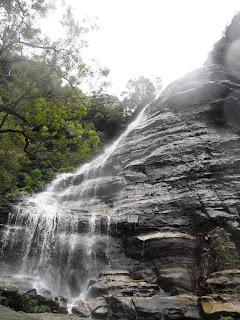After heading back to Sydney with Erica and Stefania (a couple of Italian girls that we met in Adelaide) we decided to head up to the Blue Mountains for a couple of days of bushwalking. After a two hour train ride from Sydney, we departed the train in Katoomba, our jumping off point.
After dropping our bags off at our hostel (as I’m now starting to resent every single item in my backpack), we headed down to the information centre to get some guidance on what walks we could do, and what sites we couldn’t miss. Needless to say, the walks and sites are endless – which means I may have to make a return visit before I depart Australia because we couldn’t see it all.
The most photographed site in all of the Blue Mountains is the “Three Sisters”, a rock formation easily viewed from Echo Point. The local legend is that the Three Sisters was created when a sorcerer turned three beautiful sisters into stone to protect them from the advances of three men. Unfortunately the sorcerer died before he could reverse the spell, and there they rest. Luckily it was sunny and clear, and I was able to get some decent pictures.
We did a quick walk in along the cliff face to the Katoomba Falls. What was supposed to be an easy walk was turned quite challenging by the rain that had fallen the day before, turning parts of the path into a puddled, muddy mess. Made even more challenging by the wearing of flip flops rather than actual walking shoes. Lesson learned, and it was a good thing.
As an aside, that isn’t a smoky haze covering the mountain range. The Blue Mountains are named the Blue Mountains because of the blue haze that is given off by the oils in the abundant eucalypt trees in the gorges.
The next day, we set out on our really long hike, consisting of the Prince Henry Cliff walk, to the waterfalls, then down from very narrow and treacherous steps (a lot of very narrow and treacherous steps), along the bottom of the cliff face for 4km through a temperate rain forest, complete with ferns bigger than me, and rocks turned completely green with moss and lichen, until we came to the Furber Stairs – 1000+ stairs of pure torture back up to the top. Silly me – I didn’t charge my camera the night before, and as a result it died about 1/3 of the way through our voyage, so I’m going to have to go back and get some pictures – in particular of the leeches that live in the forest. They’re particularly adept at climbing up shoes and latching onto the first piece of skin they can find. Gross.


























































